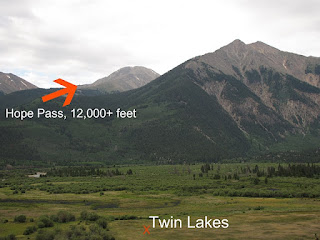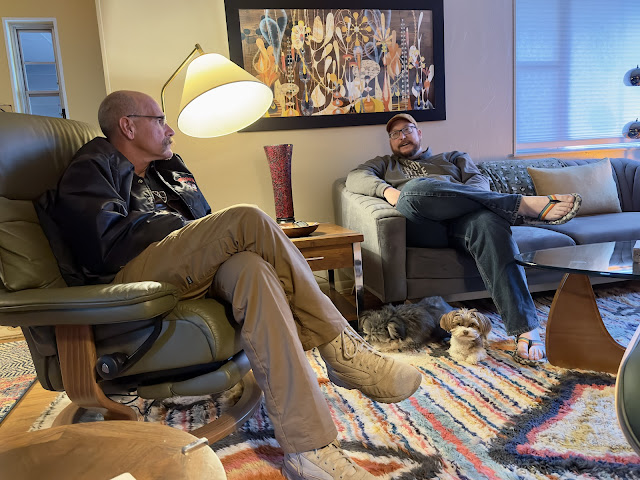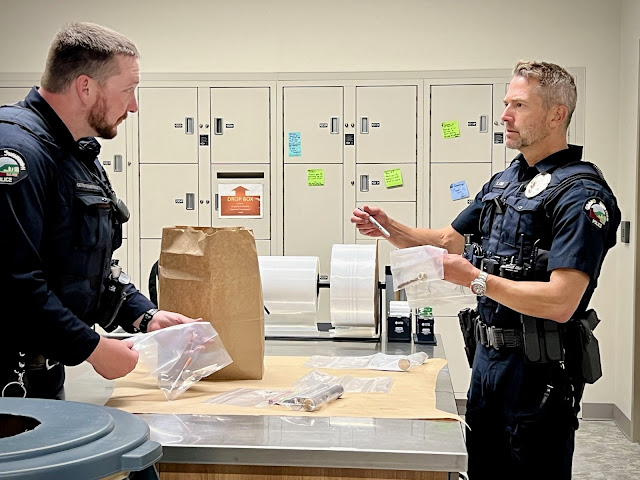How to Run the Leadville 100 Part 3: Choice, Buckle or Death?
Go on and get caught up with Part 1 and Part 2 of How to Run the Leadville 100. My patience is shallow as a puddle, so take your time.
So, now you've made it through the training and have finally arrived in Leadville the week of the race. Gasping for air while walking to the car concerns you a bit but you hope to acclimatize before race day. Funny enough, the percentage of oxygen in the air (21%) remains the same up to 70,000 feet. Interesting…(if you have no friends and thus too much time on your hands and can concern yourself with useless facts). However, it's the density (or lack thereof) of the air that makes some people feel like they're suffocating. If panting like a porn star isn't enough of an indication that you're having a tough time with higher altitude, here's a list of pleasant symptoms (nabbed off some wiki-crap page)…
Sounds like side effects of Levitra, "We'll help you get a chubby but your eyes may start bleeding." Those symptoms above will emerge just from standing in line at the one decent coffee shop in Leadville. Mix in a little 24 hours of nonstop running and you're in for more suffering than bumping into your insurance salesman neighbor at a bagpipe conference.
The race starts early, like "get your ass out of bed, sailor, you're in the navy" early. The 4am start means you have to get up around midnight to fiddle with your gear for the 80th time, eat whatever won't make your nervous stomach barf, rub Body Glide on every surface of your body until you feel like a glazed doughnut, and pray that your bowels will release before the start instead of halfway down 6th Street. It's so early that you're probably better off just staying up all night drinking. Any lingering sleepiness at the start will be exploded out of your head by the 12 gauge shotgun blast that Ken Chlouber uses to start the race (and wake up half the state). Now you're off and running at a pace more suited to a 5k. The start heads down 6th St, which is downhill for about a mile until you're dumped off onto "the boulevard", a rumbling dirt road that last for about 2.5 miles and seems more like 25 miles long when returning to the finish some 20-30 hours later.
You can pretty much predict how people are going to do in the race based on what time they reach Mayqueen aid station at mile 13. If you see a friend reach that point in, say, 1 hr 45 mins, you yell, "Man, you're killing this shit!" But really you're thinking, "That poor bastard will be a salt caked zombie with diarrhea by the time he hits 70 miles." "Great job, dude!"
By the time you finally wake up and are conscious by 8 or 9am, you've already covered about the distance of a marathon and think, "just three more marathons to go…" As mentioned, much of the course is mostly open and runnable and, with over a 1,000 people running, you're never really out there in the wilderness alone like some 100s where you feel like you could be on the wrong end of a snuff movie in the woods at any given time. In fact, most of the first 40 miles of the course are, well, boring. Once you reach Twin Lakes at mile 40, that changes. There are a lot of people, both locals and race related, hanging out, cheering, enjoying the day, and likely thanking God they aren't moronic enough to attempt something as dumb as what you're doing. If you glance up, you see Hope Pass looming tall in the distance and realize you'll have to get over that thing, twice. Suddenly, the race has a new meaning and seems much bigger than the 40 miles you've been enjoying so far.
To make the climb over Hope Pass (12,600 ft) just a little more interesting, you have to cross Lake Creek (which feeds the twin lakes and is the only point at which you get wet feet, unless you piss on yourself - been there, done that), so you have soaking wet feet before the climb up to one of the weirdest aid stations in ultras. After about an hour of climbing up a trail that would be beautiful if you weren't brain dead from being asphyxiated, you pop out onto this beautiful meadow and suddenly feel as though you're in some cool dream with flowers, soft music, and girls in light sundresses. Then you see a fairly large animal that looks vaguely like a camel, then another, then several of them. Just before you're almost ready to swear off anymore cheap LSD sheets from your SoCal friend, you realize you're at the Hopeless aid station on Hope Pass and those weird animals fucking up your cool dream are llamas.
They use the llamas to haul all the aid station gear up the mountain. You're so messed up from lack of oxygen that you can barely make small talk with the "interesting" folks who manage the aid station, so you just sip the soup broth placed in your hands, wave weakly to no one in particular, and wander off to complete Hope Pass and make your way down to Winfield, the 50 mile halfway point.
If you're lucky enough to have tricked one of your (soon to be ex) friends to pace you, Winfield is where the pacing begins (refer to my pacing guide here). If you turn around and get started out of Winfield quickly enough, you have a chance of not coming to your senses and just ending the suffering and quitting right there. Dropping isn't so bad. It only wears on your mind every day for the rest of your life. No biggie. To avoid the guilt a blind Jewish mother would be proud of, you continue on. By the time you get back to Twin Lakes, the party is pretty much over and you waddle through the aid station, get weighed in, find that you're down about 10 pounds since starting the race, even though you're hands are swollen like you got stung on each finger by killer African bees. Now that it's night time and cold out, your appetite for certain food changes. A grilled cheese sandwich cut into four cute triangle shapes and Gold Fish crackers are the best things you've ever tasted in your life, even though normally you consider both of them fit for a four year old child. In fact, I just realized that aid station volunteers treat you more and more like a child as the race progresses. Says a lot about the mental state required to sign up for one of these things.
The rest of the run is a painful blur until you get to Mayqueen at mile 87. Depending on your condition (likely shitty), this last 13 miles can take you anywhere from 2 to 16 hours. If you hit Mayqueen 20 hours into the race, you have a great shot at finishing under 25 hours and getting the big buckle (the entire point of the race and the last six months of wasted life). The big buckle is, well, big and, as Americans, we always want big.
The smaller buckle isn't worth showing a picture of in this post. It's like the size of a quarter and comes with a Hello Kitty pink cotton belt. You get the smaller buckle for finishing in 25-30 hours. If you finish after 30 hours, you should find another hobby because if you have the 60,000 hours per year of time to spend on a hobby, you could be a kick ass quilt knitter.
Now that you have the big buckle, go back to that holiday party this year and be the center of attention. You will surely lure another idiot who can't talk to women into wanting to run Leadville for the sole purpose of impressing girls with a shiny buckle. And, really, do we want a girl who is impressed by a shiny belt buckle? (yes).
So, now you've made it through the training and have finally arrived in Leadville the week of the race. Gasping for air while walking to the car concerns you a bit but you hope to acclimatize before race day. Funny enough, the percentage of oxygen in the air (21%) remains the same up to 70,000 feet. Interesting…(if you have no friends and thus too much time on your hands and can concern yourself with useless facts). However, it's the density (or lack thereof) of the air that makes some people feel like they're suffocating. If panting like a porn star isn't enough of an indication that you're having a tough time with higher altitude, here's a list of pleasant symptoms (nabbed off some wiki-crap page)…
- Lack of appetite, nausea, or vomiting
- Fatigue or weakness
- Dizziness or lightheadedness
- Insomnia
- Pins and needles
- Shortness of breath upon exertion
- Nosebleed
- Persistent rapid pulse
- Drowsiness
- General malaise
- Peripheral edema (swelling of hands, feet, and face).
The race starts early, like "get your ass out of bed, sailor, you're in the navy" early. The 4am start means you have to get up around midnight to fiddle with your gear for the 80th time, eat whatever won't make your nervous stomach barf, rub Body Glide on every surface of your body until you feel like a glazed doughnut, and pray that your bowels will release before the start instead of halfway down 6th Street. It's so early that you're probably better off just staying up all night drinking. Any lingering sleepiness at the start will be exploded out of your head by the 12 gauge shotgun blast that Ken Chlouber uses to start the race (and wake up half the state). Now you're off and running at a pace more suited to a 5k. The start heads down 6th St, which is downhill for about a mile until you're dumped off onto "the boulevard", a rumbling dirt road that last for about 2.5 miles and seems more like 25 miles long when returning to the finish some 20-30 hours later.
You can pretty much predict how people are going to do in the race based on what time they reach Mayqueen aid station at mile 13. If you see a friend reach that point in, say, 1 hr 45 mins, you yell, "Man, you're killing this shit!" But really you're thinking, "That poor bastard will be a salt caked zombie with diarrhea by the time he hits 70 miles." "Great job, dude!"
By the time you finally wake up and are conscious by 8 or 9am, you've already covered about the distance of a marathon and think, "just three more marathons to go…" As mentioned, much of the course is mostly open and runnable and, with over a 1,000 people running, you're never really out there in the wilderness alone like some 100s where you feel like you could be on the wrong end of a snuff movie in the woods at any given time. In fact, most of the first 40 miles of the course are, well, boring. Once you reach Twin Lakes at mile 40, that changes. There are a lot of people, both locals and race related, hanging out, cheering, enjoying the day, and likely thanking God they aren't moronic enough to attempt something as dumb as what you're doing. If you glance up, you see Hope Pass looming tall in the distance and realize you'll have to get over that thing, twice. Suddenly, the race has a new meaning and seems much bigger than the 40 miles you've been enjoying so far.
 |
| All of a sudden, this doesn't seem like such a great idea. photo stolen. |
To make the climb over Hope Pass (12,600 ft) just a little more interesting, you have to cross Lake Creek (which feeds the twin lakes and is the only point at which you get wet feet, unless you piss on yourself - been there, done that), so you have soaking wet feet before the climb up to one of the weirdest aid stations in ultras. After about an hour of climbing up a trail that would be beautiful if you weren't brain dead from being asphyxiated, you pop out onto this beautiful meadow and suddenly feel as though you're in some cool dream with flowers, soft music, and girls in light sundresses. Then you see a fairly large animal that looks vaguely like a camel, then another, then several of them. Just before you're almost ready to swear off anymore cheap LSD sheets from your SoCal friend, you realize you're at the Hopeless aid station on Hope Pass and those weird animals fucking up your cool dream are llamas.
 |
| WTF. Looks like a humpless camel with a Bob Marley wig. photo, yep, stolen. |
If you're lucky enough to have tricked one of your (soon to be ex) friends to pace you, Winfield is where the pacing begins (refer to my pacing guide here). If you turn around and get started out of Winfield quickly enough, you have a chance of not coming to your senses and just ending the suffering and quitting right there. Dropping isn't so bad. It only wears on your mind every day for the rest of your life. No biggie. To avoid the guilt a blind Jewish mother would be proud of, you continue on. By the time you get back to Twin Lakes, the party is pretty much over and you waddle through the aid station, get weighed in, find that you're down about 10 pounds since starting the race, even though you're hands are swollen like you got stung on each finger by killer African bees. Now that it's night time and cold out, your appetite for certain food changes. A grilled cheese sandwich cut into four cute triangle shapes and Gold Fish crackers are the best things you've ever tasted in your life, even though normally you consider both of them fit for a four year old child. In fact, I just realized that aid station volunteers treat you more and more like a child as the race progresses. Says a lot about the mental state required to sign up for one of these things.
The rest of the run is a painful blur until you get to Mayqueen at mile 87. Depending on your condition (likely shitty), this last 13 miles can take you anywhere from 2 to 16 hours. If you hit Mayqueen 20 hours into the race, you have a great shot at finishing under 25 hours and getting the big buckle (the entire point of the race and the last six months of wasted life). The big buckle is, well, big and, as Americans, we always want big.
 |
| Here's my Leadville buckle. That's right, ladies, the big one. |
Now that you have the big buckle, go back to that holiday party this year and be the center of attention. You will surely lure another idiot who can't talk to women into wanting to run Leadville for the sole purpose of impressing girls with a shiny buckle. And, really, do we want a girl who is impressed by a shiny belt buckle? (yes).




You continue to impress Tim. Too funny.
ReplyDeleteTo whom it may concern,
ReplyDeletePlease take down the screenshot of our website. You are in violation of copyright infringement by showing a picture of our website showing a picture of you. Inception, bitch!
Sincerely,
Leadville Management
This blog might be better titled "Tales from a grumpy old Footfeathers" rather than just "Footfeathers."
ReplyDeleteEnjoy your end of the game with the Luchinator this weekend.
dustin: thank you.
ReplyDeleteskatona: excellent.
gz: anyone who reads my stuff as originating from a grumpy perspective is misreading it. There's humor in just about everything, even death.
don't tell anyone but I know the humor. Grumpy is good stuff in my book.
ReplyDeleteI have to confess, I really loved this series. Don't tell!
ReplyDeleteTim, it's been too long since I've checked into your blog. Thank goodness I stumbled upon Parts 1, 2 and 3 because it's awesome writing! (like, totally says this can't-write-for-shit retro Valley Girl). I wrote a way too serious blog post today, and your series reminds me to lighten up and see the humor. Have a great run! Hope to see you on the trail again one of these days.
ReplyDeleteFootfeathers humor may take some getting used to, but I hear being a **** can produce humor, so we'll try to stick around in the hopes some day that may happen.
ReplyDeleteJust kidding man, very funny posts.
>do we want a girl who is impressed by a shiny belt buckle? (yes)
And can pace and crew.
This was the best blog post I've actually ever read. Thanks for the laugh and a belated congrats on your big shiny buckle.
ReplyDeleteHahah, great blog post. Well done!!!
ReplyDeleteI read this as I sat contemplating signing up for the LT100 in 2014, and thinking of all the things I'd have to do differently to finally finish the $%!@ thing. I tried in 2011 and got cut at the last aid station, and didn't even early the "Hello Kitty" version of the buckle. With how Lifetime Fitness continues to wreck the race further each year (2013 was horrific), I quite enjoyed your blog. I'm looking forward to finally getting my buckle next year, and then never feeling like I need to run that sucker again. - Lisa
ReplyDeleteFunniest thing I've read in a long time... good job!
ReplyDelete